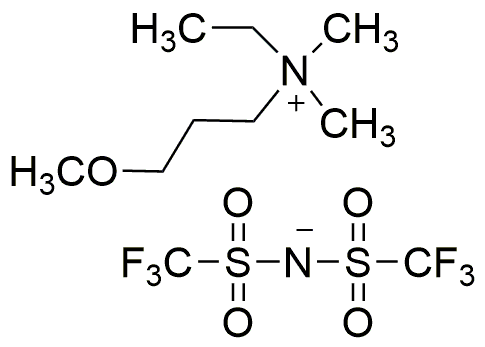Ethyl(3-methoxypropyl)dimethylammonium bis(trifluoromethanesulfonyl)imide is widely utilized in research focused on:
- Electrolytes for Energy Storage: This compound serves as an effective electrolyte in lithium-ion batteries, enhancing conductivity and stability, which is crucial for improving battery performance and longevity.
- Solvent Systems in Organic Synthesis: It acts as a solvent for various organic reactions, providing a medium that can improve reaction rates and yields, particularly in complex syntheses.
- Ion-Conducting Membranes: The chemical is used in the development of advanced ion-conducting membranes for fuel cells, contributing to higher efficiency and lower operational costs in energy conversion technologies.
- Pharmaceutical Applications: It is explored in drug formulation processes, where its unique properties can enhance solubility and bioavailability of active pharmaceutical ingredients.
- Electrochemical Sensors: This compound is utilized in the fabrication of electrochemical sensors, providing sensitive detection capabilities for various analytes, which is essential in environmental monitoring and quality control.
General Information
Properties
Safety and Regulations
Applications
Ethyl(3-methoxypropyl)dimethylammonium bis(trifluoromethanesulfonyl)imide is widely utilized in research focused on:
- Electrolytes for Energy Storage: This compound serves as an effective electrolyte in lithium-ion batteries, enhancing conductivity and stability, which is crucial for improving battery performance and longevity.
- Solvent Systems in Organic Synthesis: It acts as a solvent for various organic reactions, providing a medium that can improve reaction rates and yields, particularly in complex syntheses.
- Ion-Conducting Membranes: The chemical is used in the development of advanced ion-conducting membranes for fuel cells, contributing to higher efficiency and lower operational costs in energy conversion technologies.
- Pharmaceutical Applications: It is explored in drug formulation processes, where its unique properties can enhance solubility and bioavailability of active pharmaceutical ingredients.
- Electrochemical Sensors: This compound is utilized in the fabrication of electrochemical sensors, providing sensitive detection capabilities for various analytes, which is essential in environmental monitoring and quality control.
Documents
Safety Data Sheets (SDS)
The SDS provides comprehensive safety information on handling, storage, and disposal of the product.
Product Specification (PS)
The PS provides a comprehensive breakdown of the product’s properties, including chemical composition, physical state, purity, and storage requirements. It also details acceptable quality ranges and the product's intended applications.
Certificates of Analysis (COA)
Search for Certificates of Analysis (COA) by entering the products Lot Number. Lot and Batch Numbers can be found on a product’s label following the words ‘Lot’ or ‘Batch’.
*Catalog Number
*Lot Number
Certificates Of Origin (COO)
This COO confirms the country where the product was manufactured, and also details the materials and components used in it and whether it is derived from natural, synthetic, or other specific sources. This certificate may be required for customs, trade, and regulatory compliance.
*Catalog Number
*Lot Number
Safety Data Sheets (SDS)
The SDS provides comprehensive safety information on handling, storage, and disposal of the product.
DownloadProduct Specification (PS)
The PS provides a comprehensive breakdown of the product’s properties, including chemical composition, physical state, purity, and storage requirements. It also details acceptable quality ranges and the product's intended applications.
DownloadCertificates of Analysis (COA)
Search for Certificates of Analysis (COA) by entering the products Lot Number. Lot and Batch Numbers can be found on a product’s label following the words ‘Lot’ or ‘Batch’.
*Catalog Number
*Lot Number
Certificates Of Origin (COO)
This COO confirms the country where the product was manufactured, and also details the materials and components used in it and whether it is derived from natural, synthetic, or other specific sources. This certificate may be required for customs, trade, and regulatory compliance.


